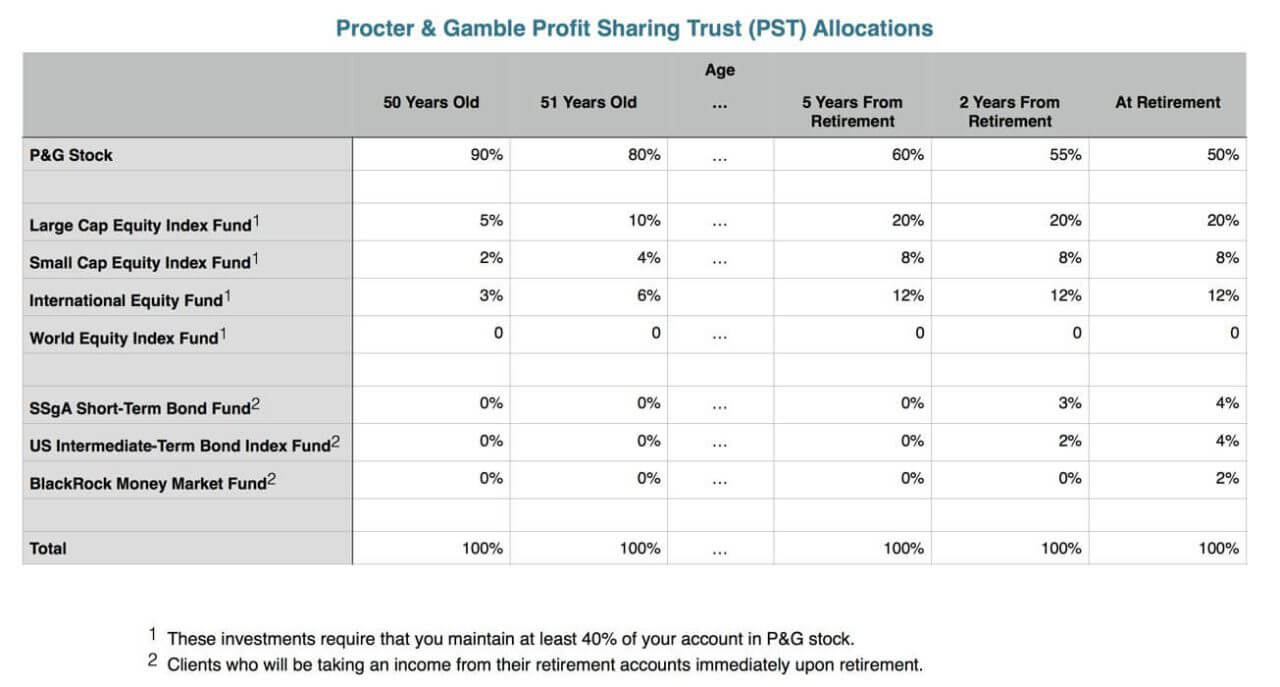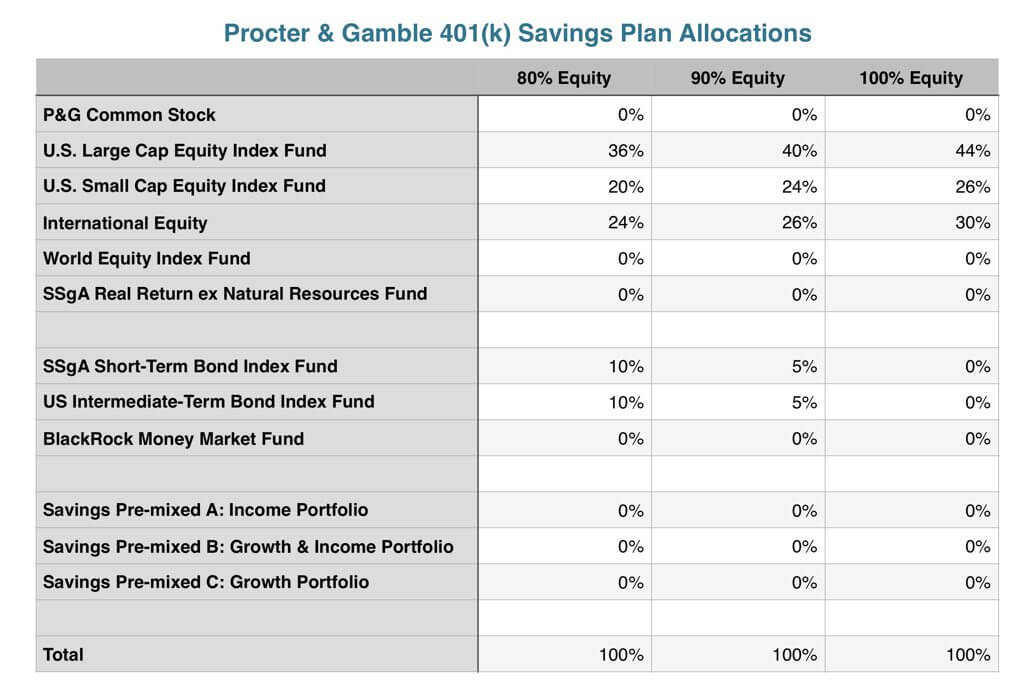As Procter & Gamble stock’s price increases, we get questions from people about when and how to diversify their Profit Sharing Trust (PST) and 401(k) accounts. We thought it might be helpful to publish some information about how we guide our clients through diversifying their retirement accounts at Procter & Gamble.
The purpose of this article is not to convince you to diversify your Procter & Gamble stock. There are writers out there, much more articulate than myself, who can help assure you that diversification out of a concentrated position is a good idea. This article presents one of many possible paths that someone might choose after they have decided to diversify their retirement plan.
When you diversify your Procter & Gamble stock into other stock investments, you are still taking advantage of the benefits of investing in the stock markets. It may help to think of the stock market as a moving train. You are not getting off the train; you’re just changing seats.
Your circumstances are different
This article is written for one couple’s particular circumstances. We don’t know your exact details. We don’t know your level of comfort with the stock market or how close you are to retirement. Take this article with a grain of salt. There is no “one size fits all” allocation plan.
If you want to talk with us in person, please contact us, and we will be happy to develop personalized recommendations that take your specific circumstances into account.
Bob & Becky Smith
This is a story about Bob and Becky Smith. Bob & Becky have been at Procter and Gamble for 25 years and just turned 50. They are concerned about the amount of their net worth that P&G represents, and want to look into diversifying their retirement accounts.
Bob and Becky have been very busy raising their children and facing the demands of successful careers. Because of this, Bob and Becky are not very conversant in investments.
Their PST account is currently invested 100% in P&G stock. Procter & Gamble stock has been good to them, and they are pleased with their account balances. They do understand the risk of having all of their eggs in one basket and would like to begin diversifying.
What do they do?
We start with the Profit Sharing Trust. Conveniently for our story, Bob and Becky just turned 50 which means they have investment options in their PST that were not previously available. Before age 50, they could invest in the core options in their PST account which consists of money market and bond funds. Although Bob and Becky didn’t pay much attention to the stock market, they knew enough not to sell their P&G stock and buy any of these as long-term investments. Bob and Becky have been handsomely rewarded for their faith in the stock market. Nice work Bob and Becky.
For Bob & Becky, we want to start diversifying their accounts relatively slowly. They have spent decades watching Procter & Gamble stock make them millionaires. They have spent decades watching CNN (Crisis News Network) tell them that wall street is a vicious jungle that devours all who enter.
Because of their experience with P&G stock, Bob & Becky are comfortable with the stock. To get comfortable, they need to experience other investments that behave similarly to P&G stock but (for diversification purposes) are not P&G stock.
We recommend that Bob and Becky diversify their PST 10% at a time and get used to the behavior of the other investments. We further recommend they continue to diversify annually in 10% increments until they get to 60% P&G stock in their PST. At this point, they are probably getting close to retirement. As retirement gets closer, we want to make sure we take some money out of the stock market to be available to meet future income needs. By the time Bob and Becky get to retirement, they should have at least two years of living expenses out of the stock market. The table below illustrates this progression.

Why stop at 50%?
We stop at 50% for a couple of reasons. First, the rules of the PST (the PST is, in reality, an Employee Stock Ownership Plan or ESOP) state that we must keep at least 40% of the account in P&G stock if we want to use the other stock investments available inside the plan; we do. Secondly, we don’t want to unintentionally sell any of Bob & Becky’s preferred P&G stock shares until we have thoroughly analyzed their trustee’s cost distribution options. (Look for more on this in future blog posts)
We also coach Bob and Becky to make the transactions when P&G stock is doing well. There is no reason to panic and sell the stock when it is down. We have years to complete the diversification and get comfortable with the new investments.
What about the 401(k) plan?
As soon as you sign up for the 401(k) plan, you have access to all of the investment options available at P&G. That includes all the same investment options only available in your PST after you turn 50. The choices are minimal, but we recommend you take advantage of the diversification and invest your contributions according to the table below.

Don’t buy P&G stock in your 401(k)
It is not prudent to invest all of your retirement assets entirely in any one company’s stock. The value of your PST, any stock options or Restricted Stock Units (RSU) you have been awarded and your paycheck are all dependent on the strength of one company. This concentration exposes you to excessive risk.
The above table is relatively straightforward. We have only included asset mixes from 100% equity to 80% equity. While you are in the process of building your retirement funds, we believe it makes sense to take advantage the equity markets. As you get closer to retirement, you can shift to lower amounts of stock investments to make sure you have plenty of room when (not if) the next major stock correction occurs.
Why don’t we recommend that Bob & Becky use the pre-mix funds?
The premix funds may work for some people, but we don’t recommend using them for a couple of reasons.
- They are too conservative. Even the most aggressive pre-mix fund is 25% out of the market. Pre-mix A (the most conservative option) has a whopping 80% of your investments in fixed income and cash.
- The world stock mix is too high. In Pre-mix C, the World Equity Index represents over 57% of the stock portion of the investments.
- Too little in small-cap stocks. Pre-mix C (the most aggressive option), has only 4% of the portfolio in small-cap stocks.
We like to have more granular control of where your accounts are invested and which premiums we are counting on.
So there you have it. A reasonable diversification plan for P&G stock in your PST account and 401(k)for people who are just now beginning to consider investments outside of P&G stock.
Please keep in mind that the above advice is directed toward Bob and Becky Smith. Your circumstances are different from theirs, so this information may not be appropriate for you. Please feel free to contact us to understand how this type of advice might fit into your overall financial plan.
This article first appeared on PersonalChoiceFinancial.com. Personal Choice Financial Advisors, LLC specializes in working with Procter & Gamble employees and retirees. All rights reserved.

Just read the article about Bob/Becky and that fits the same option I am in, but older than her. I need to know how and what to do with my plan.
Cheryl, we can’t give investment advice to people without understanding their specific circumstances. Feel free to contact us at 513-588-8080 or email [email protected] and we can assist you.
I have Common and Preferred stock and age 64 – Should I invest in the IRA this year?
Hi Cheryl,
Great question. I’m not sure what IRA you are referring to. Are you thinking about an outside investment? If so, you may want to consider the benefits of Roth IRAs versus conventional IRAs. To determine if this is appropriate for you, we would need to get together and get a much better understanding of your specific circumstances such as income, retirement goals, savings, etc. Feel free to contact us at 513-588-8080 or email [email protected] if you would like to talk further.
Chris Hansen, CFP®